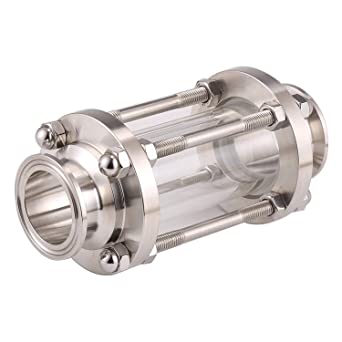
Sanitary sight glasses are essential for engineers, plant managers, and technicians, allowing them to see inside their equipment without risking contamination. With the superior hygienic design, these sight glasses have no crevices or gaps that could become a breeding ground for bacteria, ensuring a safe and healthy environment. Perfect for optimizing operations, these sight glasses make it easy to monitor your systems and avoid any potential problems.
With sanitary sight glasses, you can meet the stringent regulatory standards of your industry or application while still monitoring your system for potential problems. For example, these sight glasses allow you to watch for system blockage, harmful chemical reactions, internal corrosion or leakage, damaged equipment, and unbalanced fluid levels. This way, you can ensure your system meets the highest standards of sterility and hygiene required in the pharmaceutical industry.
Choosing the Best Design
At BCST, we understand that choosing the right design for your sanitary sight glass is essential to maximize your investment. Our experienced engineers are here to help you determine which style best suits your specific needs and operating conditions. There are three main categories of sanitary sight glasses:
- Threaded
- Fused
- Clamped
These general sight glass designs have unique specifications and capabilities that make them ideal for specific applications. It’s important to note that this refers to the housing of the sight glass, not the type of glass itself—which is just as essential to consider when selecting the right sight glass for your needs. Carefully consider each design’s specifications and abilities to choose the best sight glass for your application.
Threaded Sight Glasses
Threaded sanitary sight glasses offer engineering flexibility ideal for applications with aggressive chemicals like hydrofluoric acid, concentrated phosphoric acid, or hot concentrated alkali solutions. In addition, the threaded retainer cap in their design allows operators to easily remove the sight glass and access/clean the inside of the lens, which eliminates the need to permanently attach the sight glass to the system, allowing for components to be changed out at any point if there is damage to the glass or any operator issues arise.
However, since the sight glass can be disassembled, bacterial intrusions and threads becoming clogged with bacteria can be a concern. Without fusing the glass to the surrounding metal, safety is also a factor. However, threaded sanitary sight glasses can provide the engineering flexibility, access, and protection needed in demanding industrial applications with proper maintenance and general safety precautions.
Fused Sight Glasses
Fused sanitary sight glasses provide a unique solution to volatile applications, with their self-contained unit and metal frame around the viewing glass for increased rigidity. In addition, unlike other designs, their construction prevents breakage from uneven bolt tightening during installation.
Moreover, these sight glasses are great for preventing sudden, unexpected ruptures of the glass, which can be disastrous in specific applications and lead to catastrophic failure. Instead, the cracks that may develop will only slightly affect visibility. Therefore, fused sanitary sight glasses are an excellent choice for those looking for a reliable, secure option for more volatile applications.
Clamped Sight Glasses
Maximize your system’s efficiency and maintain optimal hygiene with clamped sanitary sight glasses. These innovative clamping systems allow fast and easy installation and removal of sight glasses without permanently modifying your equipment. This means significantly faster disassembly and cleaning processes without warping or interrupting the internal flow. Ideal for applications that require frequent cleaning or maintenance, these clamped designs will ensure your system is running smoothly and hygienically.
How to Choose the Right Glass?
Once you decide on the right sight glass design for your application, choosing the right type of glass is essential. The wrong selection can lead to broken glass due to system hazards such as overpressure, impact, or thermal shock. But by making the right choice, you can avoid these issues and ensure your system operates safely and effectively. So take the time to determine the best glass for your needs and put the right sight glass design into action.
The main types of glass glass are:
- Annealed soda-lime glass
- Tempered soda-lime glass
- Borosilicate glass
Annealed Soda Lime Glass
Annealed Soda-Lime Glass is often used for commercial purposes such as windows and drinking glasses, although it could be better for more technical applications. This type of glass is relatively inexpensive and easy to acquire. However, it is also prone to shattering from thermal shock, has poor chemical resistance, and can only be operated within a narrow temperature range. If you require a glass that can handle extreme temperatures, chemical exposure and other special conditions, consider using a different type of glass for your engineering project.
Tempered Soda Lime Glass
Tempered soda-lime glass is an ideal choice for applications where strength and durability are essential. When thermally tempered, soda-lime glass can offer up to 10,000 psi of compressive stress at its surface – a strength that is nearly twice that of ordinary annealed glass. This makes it more resistant to thermal shock and more durable and reliable than its annealed counterpart. In most cases, tempered soda-lime glass should ensure a high-performance product that will stand the test of time.
Borosilicate Glass
Borosilicate glass is an excellent choice if you want something more resistant to thermal shock. Since it has a low coefficient of thermal expansion, either regular or tempered soda-lime glass, this type of glass is often used for sight glass applications that could be subject to thermal shock or chemical attack. Not only is borosilicate glass great for these applications, but it also meets USP Type 1 standard for parenteral products, making it an excellent choice for use in pharmaceutical applications.






